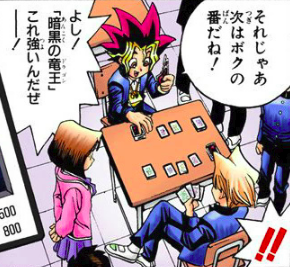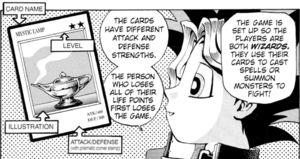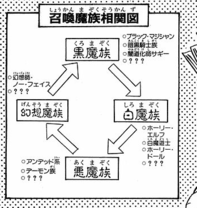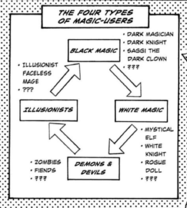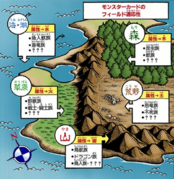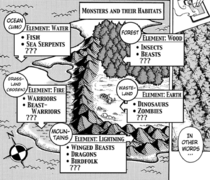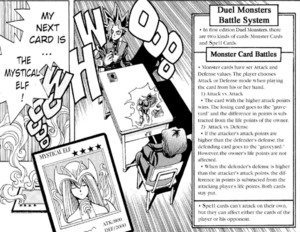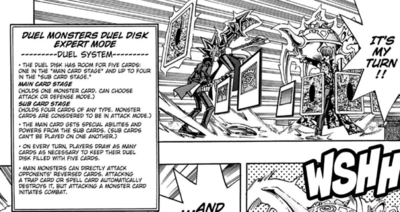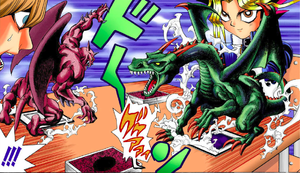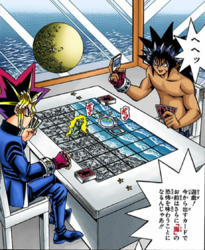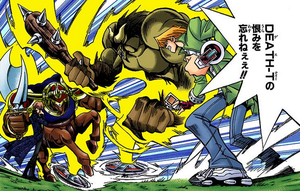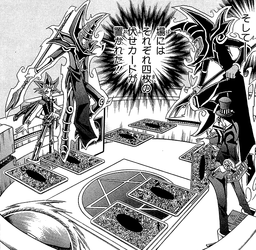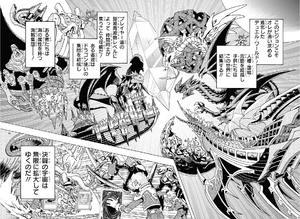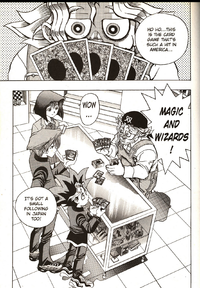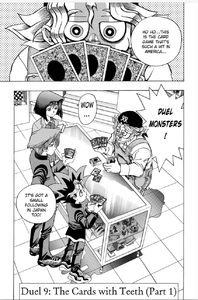Difference between revisions of "Duel Monsters (manga)"
(→Attacking: more citations) |
(Stuff from Duels 60 and 61. More Type citations, reappearance of the word 系 and Beast being weak to Fire) |
||
| Line 44: | Line 44: | ||
=====Family===== | =====Family===== | ||
| − | Family (系), unnamed in the English manga, was a division of monster.<ref name="d 10" /> | + | Family (系), unnamed in the English manga, was a division of monster.<ref name="d 10" /> It might just be a common term, referring to both Type and Attribute, as all families are also demonstrated to be Types. |
The following families appeared: | The following families appeared: | ||
| − | * [[Demon Magic (Alignment)|Demon Magic]] ({{Ruby|悪|あく}}{{Ruby|魔|ま}}, called "Fiend" in the English manga)<ref name="d 10" /> | + | * [[Demon Magic (Alignment)|Demon Magic]] ({{Ruby|悪|あく}}{{Ruby|魔|ま}}, called "Fiend" in the English manga)<ref name="d 10" /> Also shown to be an Attribute. As an Attribute, the English manga refers to it as "Demon" and "Devil".<ref name="d 62" /> |
| − | * [[Beast-Warrior]] ({{Ruby|獣|じゅう}}{{Ruby|戦|せん}}{{Ruby|士|し}})<ref name="d 10" /> | + | * [[Beast-Warrior]] ({{Ruby|獣|じゅう}}{{Ruby|戦|せん}}{{Ruby|士|し}})<ref name="d 10" /> Also shown to be a Type.<ref name="d 66" /> |
| − | * [[Zombie|Undead]] (アンデット)<ref name="d 10" /> | + | * [[Zombie|Undead]] (アンデット)<ref name="d 10" /> Also shown to be a Type. As a Type, the English manga refers to it as "Zombie".<ref name="d 62" /> |
| + | * [[Fire (Alignment)|Fire]] ({{Ruby|火|ひ}})<ref name="d 61" /> Also shown to be an Attribute.<ref name="d 66" /> | ||
=====Attribute===== | =====Attribute===== | ||
| Line 88: | Line 89: | ||
The following Types exist: | The following Types exist: | ||
* [[Magical Knight]] ({{Ruby|魔|ま}}{{Ruby|導|どう}}{{Ruby|騎|き}}{{Ruby|士|し}}, called "Warrior" in the English manga<ref name="d 37" />, which is also the name of a different Type<ref name="d 66" />) | * [[Magical Knight]] ({{Ruby|魔|ま}}{{Ruby|導|どう}}{{Ruby|騎|き}}{{Ruby|士|し}}, called "Warrior" in the English manga<ref name="d 37" />, which is also the name of a different Type<ref name="d 66" />) | ||
| + | * [[Dinosaur]] ({{Ruby|恐|きょう}}{{Ruby|竜|りゅう}})<ref name="d 60" /><ref name="d 66" /> | ||
| + | * [[Dragon]] (ドラゴン)<ref name="d 61" /><ref name="d 66" /> | ||
| + | * [[Beast]] ({{Ruby|獣|けもの}})<ref name="d 61" /><ref name="d 66" /> | ||
* [[Dark Knight]] ({{Ruby|暗|あん}}{{Ruby|黒|こく}}{{Ruby|騎|き}}{{Ruby|士|し}})<ref name="d 62" /> | * [[Dark Knight]] ({{Ruby|暗|あん}}{{Ruby|黒|こく}}{{Ruby|騎|き}}{{Ruby|士|し}})<ref name="d 62" /> | ||
* Daemon (デーモン, called "Fiend" in the English manga.<ref name="d 62" /> Although "Fiend" was also used for the "Demon Magic", 悪魔, Attribute. The Attribute being the basis for the ''[[OCG]]'' [[Fiend]] Type.) | * Daemon (デーモン, called "Fiend" in the English manga.<ref name="d 62" /> Although "Fiend" was also used for the "Demon Magic", 悪魔, Attribute. The Attribute being the basis for the ''[[OCG]]'' [[Fiend]] Type.) | ||
* [[Zombie]] (アンデット, literally "Undead")<ref name="d 62" /> | * [[Zombie]] (アンデット, literally "Undead")<ref name="d 62" /> | ||
| − | |||
* [[Warrior]] ({{Ruby|戦|せん}}{{Ruby|士|し}})<ref name="d 66" /> | * [[Warrior]] ({{Ruby|戦|せん}}{{Ruby|士|し}})<ref name="d 66" /> | ||
* [[Beast-Warrior]] ({{Ruby|獣|じゅう}}{{Ruby|戦|せん}}{{Ruby|士|し}})<ref name="d 10" /><ref name="d 66" /> | * [[Beast-Warrior]] ({{Ruby|獣|じゅう}}{{Ruby|戦|せん}}{{Ruby|士|し}})<ref name="d 10" /><ref name="d 66" /> | ||
| − | |||
* [[Winged Beast]] ({{Ruby|鳥|ちょう}}{{Ruby|獣|じゅう}})<ref name="d 66" /> | * [[Winged Beast]] ({{Ruby|鳥|ちょう}}{{Ruby|獣|じゅう}})<ref name="d 66" /> | ||
* [[Insect]] ({{Ruby|昆|こん}}{{Ruby|虫|ちゅう}})<ref name="d 66" /> | * [[Insect]] ({{Ruby|昆|こん}}{{Ruby|虫|ちゅう}})<ref name="d 66" /> | ||
| − | |||
* [[Fish]] ({{Ruby|魚|さかな}})<ref name="d 66" /> | * [[Fish]] ({{Ruby|魚|さかな}})<ref name="d 66" /> | ||
* [[Sea Serpent]] ({{Ruby|海|かい}}{{Ruby|竜|りゅう}})<ref name="d 66" /> | * [[Sea Serpent]] ({{Ruby|海|かい}}{{Ruby|竜|りゅう}})<ref name="d 66" /> | ||
| Line 103: | Line 104: | ||
* God ({{Ruby|神|かみ}})<ref>{{chapter|Yu-Gi-Oh! R|10|ref}}</ref> | * God ({{Ruby|神|かみ}})<ref>{{chapter|Yu-Gi-Oh! R|10|ref}}</ref> | ||
** The term "[[Divine-Beast|God-Beast]]" ({{Ruby|幻|げん}}{{Ruby|神|しん}}{{Ruby|獣|じゅう}}) has been mentioned in the context of the [[Egyptian God]]s, without specifically mentioning "Type".<ref name="d 147">{{chapter|Yu-Gi-Oh!|147|ref}}</ref> Despite having a dedicated Type, one of the God cards, "[[Slifer the Sky Dragon (manga)|Slifer the Sky Dragon]]", was said to be Dragon-Type, affecting the ATK of "[[Buster Blader (manga)|Buster Blader]]".<ref>{{chapter|Yu-Gi-Oh!|173|ref}}</ref> | ** The term "[[Divine-Beast|God-Beast]]" ({{Ruby|幻|げん}}{{Ruby|神|しん}}{{Ruby|獣|じゅう}}) has been mentioned in the context of the [[Egyptian God]]s, without specifically mentioning "Type".<ref name="d 147">{{chapter|Yu-Gi-Oh!|147|ref}}</ref> Despite having a dedicated Type, one of the God cards, "[[Slifer the Sky Dragon (manga)|Slifer the Sky Dragon]]", was said to be Dragon-Type, affecting the ATK of "[[Buster Blader (manga)|Buster Blader]]".<ref>{{chapter|Yu-Gi-Oh!|173|ref}}</ref> | ||
| + | |||
| + | In the Standard Rules, Beast-Type monsters are weak against Fire-Family attacks.<ref name="d 61" /> | ||
=====Abilities===== | =====Abilities===== | ||
Revision as of 16:27, 28 October 2023
Duel Monsters, known as Magic and Wizards (マジック
This is the very first incarnation of Duel Monsters and served as the basis for many of the variations to follow, including the Yu-Gi-Oh! Official Card Game and Yu-Gi-Oh! Trading Card Game.
Duel Monsters debuted when the manga had an episodic format and featured a different game nearly every week. However due to its popularity among readers, it ended up becoming the main game played throughout the series.
In-universe, Duel Monsters was invented by Maximillion J. Pegasus, as a means of reintroducing Diaha, battles played in ancient Egypt using monsters sealed in stone slabs, to the modern world.
Contents
Rules
Types of cards
The types of cards are:
- Monster Card[1]
- Spell Card[1]
- Trap Card[2]
- Equip Card[3]
- Illusion Card[4]
- Virus Card[5]
- Slot Machine Power Unit
In the Basic Rules, the only types of cards were Monster and Spell.[1]
Some cards do not exist in a physical form, but are the result of the effects of other cards. e.g. "Thousand Dragon" is "Baby Dragon" affected by "Time Wizard". It does not possess its own dedicated card, but has its own name, ATK and DEF.
It is possible for a card to have multiple card types. e.g. "Graverobber" is a Trap/Spell Card.
Non-game cards exist, such as "Soul Prison" and the Invitation Cards. These cards are not intended for use in Duels.
Monster Cards
Monster Card have the following properties, which are printed on the card:
- Level
- A rough indicator of the monster's overall strength. In the Super Expert Rules, it is used to determine the number of Tributes needed to Summon it.
- ATK and DEF
- Used in determining battle outcomes and damage calculation
- Effect
Monsters also have the following properties, which are not printed on the card:
Family
Family (系), unnamed in the English manga, was a division of monster.[1] It might just be a common term, referring to both Type and Attribute, as all families are also demonstrated to be Types.
The following families appeared:
- Demon Magic (
悪 魔 , called "Fiend" in the English manga)[1] Also shown to be an Attribute. As an Attribute, the English manga refers to it as "Demon" and "Devil".[4] - Beast-Warrior (
獣 戦 士 )[1] Also shown to be a Type.[7] - Undead (アンデット)[1] Also shown to be a Type. As a Type, the English manga refers to it as "Zombie".[4]
- Fire (
火 )[6] Also shown to be an Attribute.[7]
Attribute
An Attribute (
Monsters can have the following Attributes:
- Magic-Users
- Black Magic (
黒 魔 )[4] - White Magic (
白 魔 )[4] - Demon Magic (
悪 魔 , split into "Demon" and "Devil" in the English manga)[4] - Illusion Magic (
幻 想 魔 , called "Illusionist" in the English manga)[4]
- Black Magic (
- Monsters
- Other/not specified
Attributes can be strong and weak against other Attributes. What happens when monster of opposing Attributes battle is inconsistent. Sometimes the monster of the weaker Attribute loses half its ATK.[6] More often, nothing happens.
- Black Magic is strong against White Magic[4]
- White Magic is strong against Demon Magic[4]
- Demon Magic is strong against Illusion Magic[4]
- Illusion Magic is strong against Black Magic[4]
- Lightning is strong against Water[6]
Type
Type (族) is another division of monster. In the English manga, Type is sometimes called "Class".[10]
The following Types exist:
- Magical Knight (
魔 導 騎 士 , called "Warrior" in the English manga[10], which is also the name of a different Type[7]) - Dinosaur (
恐 竜 )[2][7] - Dragon (ドラゴン)[6][7]
- Beast (
獣 )[6][7] - Dark Knight (
暗 黒 騎 士 )[4] - Daemon (デーモン, called "Fiend" in the English manga.[4] Although "Fiend" was also used for the "Demon Magic", 悪魔, Attribute. The Attribute being the basis for the OCG Fiend Type.)
- Zombie (アンデット, literally "Undead")[4]
- Warrior (
戦 士 )[7] - Beast-Warrior (
獣 戦 士 )[1][7] - Winged Beast (
鳥 獣 )[7] - Insect (
昆 虫 )[7] - Fish (
魚 )[7] - Sea Serpent (
海 竜 )[7] - Birdfolk (
鳥 人 )[7] - God (
神 )[11]- The term "God-Beast" (
幻 神 獣 ) has been mentioned in the context of the Egyptian Gods, without specifically mentioning "Type".[12] Despite having a dedicated Type, one of the God cards, "Slifer the Sky Dragon", was said to be Dragon-Type, affecting the ATK of "Buster Blader".[13]
- The term "God-Beast" (
In the Standard Rules, Beast-Type monsters are weak against Fire-Family attacks.[6]
Abilities
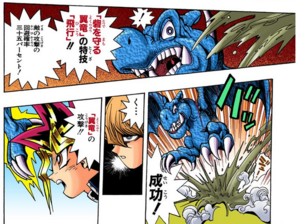
Monsters may have the following abilities:
- Flight
- This gives monsters a 35% chance to evade when attacked by a monster using a ground-based attack.[10]
- Swimming
- Magical attack
Non-Monster Cards
Non-Monster Cards have the following details printed on them:
Card effects
Some monsters and all non-monsters have effects that can influence gameplay. Not all cards with effects have their effects printed on them. Printed effects are not always complete or written in a manner than clarifies the precise technicalities of the effect.
In the English manga, printed effects often contain translation errors or show the effect the card has in the Yu-Gi-Oh! Trading Card Game, which is often different than the card's effect in manga.
Fields
Different zones that monsters are played in can have different fields.
Monsters received Field Power Sources depending on the terrain they were played in.[14]
- Forest strengthens the Wood Attribute and the Insect and Beast Types.[7]
- Grassland strengthens the Fire Attribute and the Warrior and Beast-Warrior Types.[7]
- Mountains strengthens the Lightning Attribute and the Winged Beast, Dragon and Birdfolk Types.[7]
- Wasteland strengthened the Earth Attribute and the Dinosaur and Zombie Types.[7]
- Ocean strengthened the Water Attribute and the Fish and Sea Serpent Types.[7]
- Graveyard strengthened the Zombie Type.[15]
In the Standard Rules, these fields were automatically in effect, depending on what area of the Duelist Kingdom island players Dueled in.[14]
Field Spell Cards can be used to change the field.
Sequence of play
Setup
- There are two players in each Duel.[16]
- Each player begins with 4000 Life Points.[17] (2000 before the Super Expert Rules[16])
- Each player's Deck contains 40 cards.[16] The Decks are shuffled before a Duel.[18]
- The field is laid out such that each player has space for their Deck, Graveyard and five cards in play. When played on a flat surface, typically each player's Deck is placed on their right-hand side, Graveyard on the left-hand side, cards in play are placed in between.[16] Varieties exist where the Graveyard is out of sight[1] or both Graveyards are on the same side.[7] Duel Disks have designated slots for the Deck, Graveyard and five cards in play.
- At the beginning of a Duel, each player draws five cards, which become their hand.[10]
Turns
Each turn the turn player draws one card from their Deck.[16] A player's hand cannot contain more than seven cards[17]
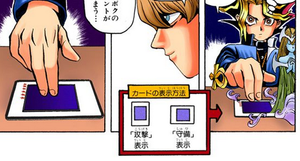
During their turn, a player can:
- Summon a monster from their hand in face-up Attack or Defense Mode.[16] Attack Mode is vertical. Defense Mode is horizontal.[1]
- In the Standard Rules, Monster Cards could be played face-down. Although this practice was only demonstrated once.[6] In the Super Expert Rules, Monster Cards cannot be played face-down. It is considered an illegal move to play a card face-down without first looking at it to determine if it is a monster or not.[19]
- Activate cards from their hand (other than Monster or Trap Cards)
- Play a non-Monster Card from their hand face-down.[1]
- Change the battle position of a monster.[10]
- Attack with Attack Mode monsters.[1]
In the Basic Rules, if a player does not have a monster on their side of the field at the end of the their turn, they can play one from their hand in Defense Mode.[10]
During their opponent's turn, a player can:
- Activate cards they played face-down.
Playing monsters
Each turn the player can Summon a monster from their hand.
Beginning with the Super Expert rules, monsters of Level 5 or higher require sacrifices to be Summoned.
- Level 5 and 6 monsters require one sacrifice.[17]
- Level 7 or higher monsters require two sacrifices.[17]
- God cards require three sacrifices.
Monsters can be Summoned by the effects of other cards. Sacrifices are not required when Summoning monsters this way.
Monsters can be fused together using the card "Polymerization".[21] "Polymerization" and the Fusion Material monsters are still in play after a Fusion. The Fusion Monster does not have a physical card.[22] In the Super Expert rules, monsters cannot attack the same turn they are Summoned with "Polymerization".[17]
Ritual Spell Cards can be used to Ritual Summon a monster by sacrificing monsters that meet a certain criteria.[23] The Ritual Monster does not possess a physical card.
Attacking
A battle is conducted when the turn player announces for one of their Attack Mode monsters is to attack an opponent's monster.
- If an Attack Mode monster battles another Attack Mode monster, the monster with the lower ATK is destroyed and its controller loses Life Points equal to the difference.[1]
When Attack Mode monsters with equal ATK battle, both are destroyed.
- If an Attack Mode monster attacks a Defense Mode monster and its ATK is higher than the defending monster's DEF, the defending monster is destroyed and no Life Points are lost.[1]
- If an Attack Mode monster attacks a Defense Mode monster and its ATK is lower than the defending monster's DEF, neither monster is destroyed and the controller of the attacking monster loses Life Points equal to the difference in the ATK and DEF.[1]
If an attack is evaded (e.g. a flying monster dodges an attack from a ground-based monster), the attacked monster may still counter attack. It will not be destroyed in the two monsters have the same ATK. The monster that attacked it loses its Field Power Source.[24]
Monsters destroyed by battle go to the Graveyard.[1]
Monsters can attack the opponent directly if the opponent has no monsters to defend with,[16][20][17] in which case the opponent loses Life Points equal to the ATK of the attacking monster.[16][20][25]
Victory conditions
A player is considered the winner if:
- They reduce their opponent's Life Points to 0.[16]
- Their opponent cannot draw a card when they are required to.[20][17]
- They use the effect of a card that makes them the winner, such as "Exodia the Forbidden One"[26] or "Destiny Board".[27]
Rule sets
Basic
These rules were used in Duel Monsters' first appearance and in Death-T. The ruleset is unnamed in the Japanese version, but called the Basic Rules[16][10] or First Edition Duel Monsters[1] in the English manga.
This is the most basic set of rules and does not feature any of the rules introduced in later rule sets.
Only rules to feature or mention:
- Players have the option to play a monster from their hand in Defense Mode at the end of their turn, if they have no other monsters.[10]
Standard
The Standard rules contained the basic rules, with some additional ones. These were used during the Japanese National Duel Monsters Championship and the Duelist Kingdom tournament.
Introduces or first mentions:
- More card types: Trap,[2] Equip[3], Illusion[4] Virus,[5] and Slot Machine Power Unit
- Field Power Source
Only rules to feature or mention:
- Monster Cards are divided into Monsters and Magic-Users[6]
- Attributes being strong or weak against other Attributes
- Fields with Field Power Sources being active by default (later rules have them set by card effects)
- Monsters can be played in face-down Attack Mode[6]
Expert
The Expert rules were used with the first version Duel Disks. This alters many of the previous rules and adds more.
Only rules to feature or mention:
- Each player can only hold five cards at a time.[22]
- If a player has five cards at the start of their turn, they cannot draw a card.[22]
- If a player has fewer than five cards at the start of their turn, they draw until they have five.
- A player's field contains five stages; the main card stage and four sub card stages. The main card is played in the main stage. All the player's other cards in their hand are played in the sub stages.[28]
- Monsters in the main monster can be played in Attack or Defense Mode. Monsters in the sub stages are all in Attack Mode.[28]
- The main card gets special abilities and powers from the sub cards.[28]
- Sub cards are face-down until used or attacked.[28]
- Sub cards can be flipped face-down and shuffled.[28]
- A player's main monster can attack their opponent's main monster or any of the opponent's face-down cards. Normal rules of battle are applied if they attack a Monster Card. Non-Monster Cards are automatically destroyed if they are attacked.[28]
Super Expert
The Super Expert rules were introduced in the Battle City tournament. They are based on the standard rules, contain additional rules and alter previous ones. The Expert rules do not apply in Super Expert.
Introduces or first mentions:
- Starting Life Points are changed from 2000 to 4000.[17]
- Sacrifice Summon[17]
- Hand size limit[17]
- Monsters not being able to attack the turn they are fused with "Polymerization".[17]
Realistic projections of cards
Multiple methods have been used to create lifelike projections of the cards while playing Duel Monsters.
- Cards have been brought to life by Millennium Item holders through use of Shadow Games.[16] The Shadow Game's players can see the conjured monsters or effects of cards,[16][29] but spectators cannot.[30]
- KaibaCorp used holographic technology to create projections of cards to artificially replicate the experience of the Shadow Games. This was mainly done through the use of Virtual Simulation Battle Boxes.[31]
- KaibaCorp later invented Solid Vision, which created even more realistic and life-sized projections of the cards. And invented Duel Disks as as a means of creating the projections from cards.[32][33] Despite Solid Vision also being holograms, players feel like they experience pain when attacked by Solid Vision monsters.[25]
- KaibaCorp also invented the Neurons as a means of playing Duel Monsters in the Duel Links virtual reality.[34]
Monsters in a Shadow Game
Holograms in a Virtual Simulation Battle Box
Solid Vision projections from the prototype Duel Disks
Virtual reality created using Neurons
History
Egyptian Diaha
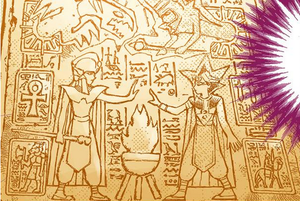
In ancient Egypt, it was believed that misfortunes were caused by evil spirits dwelling inside people. In order to bring peace, the Pharaoh's magicians tamed such spirits, gave them names and physical forms, and trapped them in stone slabs. While sealed the monsters slowly became more powerful. Eventually a group of Priests acted against the Pharaoh and harnessed the power of the stone slabs, using them to and summon the monsters from the tablets to fight in battles, known as Diaha.[35]
The magicians eventually died out and the stone tablets fell asleep deep below the earth. The legend was recorded in the Book of Thoth and passed down from generation to generation. All card games were said to have sprang from this source.[36]
Creation
Maximillion J. Pegasus became interested in the ancient Egyptian beliefs in life after death, following the death of his lover, Cyndia. This led him to Egypt to learn more.[37]
At the village, Kul Elna, Pegasus failed to bargain with Shadi for the safety of a a thief who was to persecuted for his attempt to steal the Millennium Ring. Pegasus spied on the thief being put on trial to see if he was chosen by the Ring. However the Ring rejected the thief as a host, burning him to death in the process. Pegasus was caught spying on the ritual and not permitted to leave unless he became bearer of a Millennium Item. For his trial, Pegasus had his left eye was cut out and the Millennium Eye inserted into in its socket. The Eye accepted Pegasus and showed him an apparition of Cyndia.[37]
In the Valley of the Kings, Pegasus heard the legends of the Egyptian magicians that battled using the monsters sealed in tablets. He created Duel Monsters as a means of bringing the ancient games to the modern world,[36] an act Ishizu Ishtar claimed he was led by fate to do.[12]
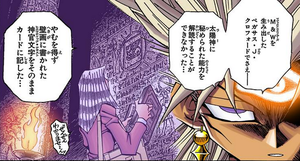
Pegasus based a number of cards on images he saw on stone carvings. This included the three Hidden Gods of Egypt depicted on the Tablet of Lost Memories, each of which he designed as a one-of-a-kind card.[12] The Sun Dragon Ra had its abilities carved into a tablet in hieratic text. Unable to translate them, Pegasus resigned to simply transcribing the hieratic text directly onto the card, leaving him unaware of its effects. He used a special kind of ink that would only be visible in the light emitted by Ra.[38] It was said that whoever acquires the three God cards would be given the title of "Duel King". However the cards gained great power as if the Gods actually resided in them and were capable of taking an opponent's life. Pegasus regretted their creation, considering it to be his greatest mistake. He tried to physically destroy the cards, but could not bring himself to do it, and opted to have them buried within the Valley of the Kings, where they had come from.[12]
The card "Blue-Eyes White Dragon" was based on The White Dragon seen on the Tablet of Lost Memories.[12] It was initially considered to be one of the most powerful cards, so overpowered that production was ceased, causing it to gain a high monetary among collectors.[16] Four copies were known to exist. They fell into the hands of collectors in the United States, Germany, and Hong Kong and Sugoroku Mutou in Japan.[31]
Rise in popularity
Duel Monsters became a huge success in the United States, with players said to be in excess of twenty million and many tournaments hosted with large prizes.[39]
The game features a number of valuable cards, with one fan in America alleged to have sold his house to pay for a single card.[16]
By the time of Death-T, Duel Monsters was considered to be the world's #1 collectible card game.[31]
Introduction of holograms
Seto Kaiba's attempt to steal the "Blue-Eyes White Dragon" from Sugoroku Mutou resulted in him being challenged to a Shadow Game of Duel Monsters by Dark Yugi. In this game, the monsters came to life as they were Summoned.[16] On defeat, Kaiba was subjected to a Penalty Game, resulting in him imagining he was trapped inside a card, causing him to reside in the World of Duel Monsters, where he suffered the Experience of Death at the hands of monsters.[1]
Kaiba invented the Virtual Simulation Battle Boxes, which created 3-D holograms of cards, as players played Duel Monsters, recreating what he witnessed in the Shadow Game. And allowed him to inflict a reconstruction of the Experience of Death on the loser.[31]
Kaiba's company, KaibaCorp, sent an offer to Pegasus to develop Virtual Simulation Battle Boxes together with Industrial Illusions, to enhance the experience of playing Duel Monsters. Pegasus described it as a great idea and said that he would love for their companies to develop it together.[39]
Battle Boxes were used during Death-T and Duelist Kingdom.
Introduction of Solid Vision
Duel Disks were developed later by KaibaCorp as a more upgraded means of Dueling that the Battle Boxes. Kaiba was in some part incentivized to develop them having witnessed the mind-reading abilities that the Millennium Eye granted Pegasus. The Duel Disks required players to stand at least 5 meters apart, which Kaiba hoped would be enough to put him out of Pegasus' Mind Scan's range. Unlike Battle Boxes the Duel Disks used Solid Vision, which created life-sized projections[32] and were considered to be much more realistic than the holograms used by the Battle Boxes.[33]
Pegasus was fond of the Solid Vision technology as it was capable of creating projections that were more lifelike than simple holograms. He hoped to takeover KaibaCorp, so he could have the technology and make it even more lifelike and create a realistic reconstruction of Cyndia, whom he had created a card of.[33]
Real-world information
Name
The game is called Magic and Wizards or M&W for short in the Japanese manga. However, due to its similarity to Magic: The Gathering, the game was renamed to Duel Monsters in other media. Despite this, the Japanese manga continued to call the game Magic and Wizards throughout its run.
When the English manga was first printed in the Shonen Jump magazine, it used the name Magic and Wizards.[16] This name was also used in the first printing of the graphic novels. In subsequent reprints, the name was changed to Duel Monsters.
Design
The Yu-Gi-Oh! manga originally featured many different games, which rarely appeared more than once. Duel Monsters was initially meant to only feature in two chapters.[40] However, Shueisha, the publisher of the Weekly Shōnen Jump magazine, received so many letters and fan-mail asking about the game that Kazuki Takahashi was encouraged to extend it.[41]
Takahashi came up with the original rules for the game in a single night.[40] The idea for holograms and Solid Vision was inspired by Dejarik, a board game in Star Wars that featured holographic pieces.[42]
Adaptations
- The Yu-Gi-Oh! anime by Toei Animation featured a version of Duel Monsters, based on the manga game. It first appeared April 18, 1998. The game was renamed from Magic and Wizards to Duel Monsters for this medium. Although the card backings featured the letters "MW".
- The Yu-Gi-Oh! Cardass by Bandai, first released August 1998, is based on the manga game.
- The Yu-Gi-Oh! Duel Monsters video game by Konami, released December 16, 1998, and a number of its sequels features a Duel Monsters game, based on the one from the manga. The series uses the name Duel Monsters. Although the game is called Magic at one point in dialogue.
- The Yu-Gi-Oh! Official Card Game (OCG) by Konami, first released February 4, 1999, incorporated elements from the manga game and the video game. Its logo features the term Duel Monsters. Earlier pre-production logos also featured the name Magic & Wizards Official Card Game.
- The Yu-Gi-Oh! anime by Nihon Ad Systems, first appearing April 18, 2000, features a Duel Monsters card game, based on the manga game, also incorporating elements from the OCG.
Notes
- ↑ Generally, the rule that each monster can only attack once per turn is implied, rather than stated outright, as players are never shown to attack with the same monster more than once per turn. It is somewhat stated in Yu-Gi-Oh! Duel 38: "The Terror of Blue-Eyes!!" when Dark Yugi says that Kaiba's two "Blue-Eyes White Dragons" can destroy two of his monsters each turn.
References
- ↑ a b c d e f g h i j k l m n o p q r Yu-Gi-Oh! Duel 10: "The Cards with Teeth (Part 2)"
- ↑ a b c Yu-Gi-Oh! Duel 60 (Duelist Duel 1): "Challenge!!"
- ↑ a b Yu-Gi-Oh! Duel 70 (Duelist Duel 11): "Things that Don't Change"
- ↑ a b c d e f g h i j k l m n o Yu-Gi-Oh! Duel 62 (Duelist Duel 3): "Countdown!!"
- ↑ a b Yu-Gi-Oh! Duel 109 (Duelist Duel 50): "The Deadly Duelist King!"
- ↑ a b c d e f g h i j Yu-Gi-Oh! Duel 61 (Duelist Duel 2): "Don't Draw That Card!!"
- ↑ a b c d e f g h i j k l m n o p q r s t u v w x Yu-Gi-Oh! Duel 66 (Duelist Duel 7): "The Trap"
- ↑ Yu-Gi-Oh! R Duel Round 8: "Dweller in the Dark!!"
- ↑ Yu-Gi-Oh! Duel 110 (Duelist Duel 51): "Toons Attack!"
- ↑ a b c d e f g h i Yu-Gi-Oh! Duel 37: "To the Death!!"
- ↑ Yu-Gi-Oh! R Duel Round 10: "A World Ruled by Terror!!"
- ↑ a b c d e Yu-Gi-Oh! Duel 147 (Duelist Duel 88): "The Lost Cards"
- ↑ Yu-Gi-Oh! Duel 173 (Duelist Duel 114): "Combo of Despair!!"
- ↑ a b Yu-Gi-Oh! Duel 65 (Duelist Duel 6): "Let the Duel Begin!"
- ↑ Yu-Gi-Oh! Duel 89 (Duelist Duel 30): "Duel Without End"
- ↑ a b c d e f g h i j k l m n o p Yu-Gi-Oh! Duel 9: "The Cards with Teeth (Part 1)"
- ↑ a b c d e f g h i j k Yu-Gi-Oh! Duel 153 (Duelist Duel 94): "Duel of Vengeance!"
- ↑ Yu-Gi-Oh! Duel 36: "Battle Beyond Hope"
- ↑ Yu-Gi-Oh! Duel 269 (Duelist Duel 210): "Card of Fate!!"
- ↑ a b c d Yu-Gi-Oh! Duel 38: "The Terror of Blue-Eyes!!"
- ↑ Yu-Gi-Oh! Duel 68 (Duelist Duel 9): "Demon Lightning"
- ↑ a b c Yu-Gi-Oh! Duel 105 (Duelist Duel 46): "No Mercy"
- ↑ Yu-Gi-Oh! Duel 108 (Duelist Duel 49): "The First Stages of Fear!"
- ↑ Yu-Gi-Oh! Duel 69 (Duelist Duel 10): "The Siren"
- ↑ a b Yu-Gi-Oh! Duel 156 (Duelist Duel 97): "Esper Roba"
- ↑ Yu-Gi-Oh! Duel 39: "Endgame!!"
- ↑ Yu-Gi-Oh! Duel 205 (Duelist Duel 146): "The Undying Grudge!"
- ↑ a b c d e f Yu-Gi-Oh! Duel 102 (Duelist Duel 43): "A Close Fight!"
- ↑ Yu-Gi-Oh! Duel 60 (Duelist Duel 1): "Challenge!!"
- ↑ Yu-Gi-Oh! Duel 61 (Duelist Duel 2): "Don't Draw That Card!!"
- ↑ a b c d Yu-Gi-Oh! Duel 27: "Project Start!"
- ↑ a b Yu-Gi-Oh! Duel 85 (Duelist Duel 26): "Duelist's Honor"
- ↑ a b c Yu-Gi-Oh! Duel 133 (Duelist Duel 74): "The Precious Piece"
- ↑ Yu-Gi-Oh! "TRANSCEND GAME (part 1)"
- ↑ Yu-Gi-Oh! Duel 146 (Duelist Duel 87): "The Ancient Stone"
- ↑ a b Yu-Gi-Oh! Duel 129 (Duelist Duel 70): "The Sacrifice!"
- ↑ a b Yu-Gi-Oh! Duel 132 (Duelist Duel 73): "The Tragic Tale of the Millennium Eye"
- ↑ Yu-Gi-Oh! Duel 222 (Duelist Duel 163): "The Rise of Ra!"
- ↑ a b Yu-Gi-Oh! Duel 87 (Duelist Duel 28): "The Terror of Pegasus!"
- ↑ a b Yu-Gi-Oh! volume 30 (Duelist volume 23): "Ra the Immortal"; foreward
- ↑ Lisa Takeuchi Cullen (November 8, 2002). "Kazuki Takahashi, Yu-Gi-Oh! creator". Time for Kids. Archived from the original on July 14, 2007. Retrieved June 12, 2023.
- ↑ Duel Art "An Interview with Kazuki Takahashi"; page 2
